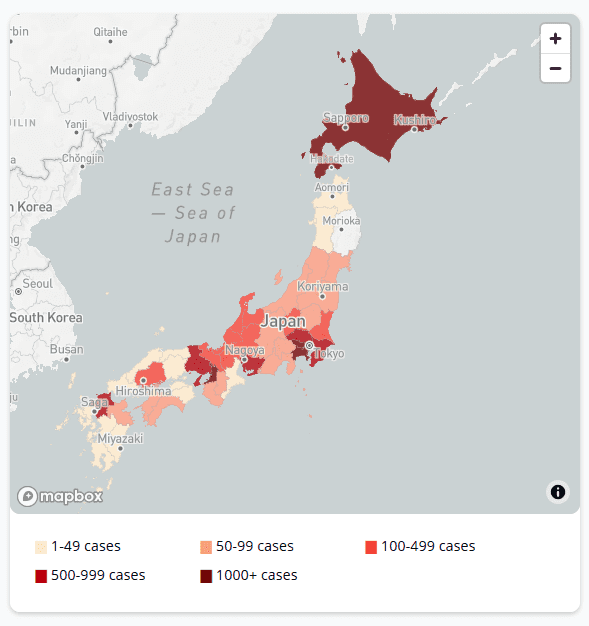
Is Japan Safe from the Coronavirus?
The coronavirus outbreak is casting a shadow over tourism in Japan and is already having a major impact on tourism, society and the economy. Here at Japan Travel Advice we have been receiving many messages and emails from concerned travelers worried about their trip to Japan for 2020.
On the streets, I have witnessed less crowds than usual at tourist spots as well as more many people wearing surgical masks, which have all sold out across the country. Out in public, there are notices in place advising people to take precautionary protection measures as such thoroughly washing their hands, gargling water and wearing surgical masks when out in public.
Many major sporting and cultural events have been cancelled, delayed or scaled down due to the Coronavirus (COVID-19) with concerns raised about staging the Tokyo 2020 Summer Olympics later on in the year.
Update: Tuesday, March 24th
Prime Minister Shinzo Abe and IOC head Thomas Bach have agreed to hold the Tokyo Olympics by the summer of 2021 at the latest.
Most of Japan’s tourist attractions are currently closed, and festivals and events have been cancelled or postponed across the nation.
Tokyo Disneyland and Tokyo Disney Sea will remain closed from February 29 until the middle of May over fears of the coronavirus outbreak.
Universal Studios Japan in Osaka will close temporarily from Saturday, February 29 until mid-May to help curb the spread of the new coronavirus outbreak.
Prime Minister Shinzo Abe said on Thursday, February 27 that the government will request all elementary, junior high and high schools in Japan to close from Monday, March 2nd until the end of spring break amid concern over the spread of the new coronavirus.
Travel Restrictions
From Friday, April 3, the Japanese government will ask all travelers to Japan, including Japanese nationals, to self-isolate for two weeks and avoid public transportation to prevent the further spread of new coronavirus infections. This measure will be in place until the end of April.
The government will also expand an entry ban on foreign visitors from 49 countries and regions, including the United States, Canada, China, South Korea, Britain, and most parts of Europe, bringing the total to 73 counties and regions.
The Australian Government has raised its travel advisory to Level 4 (Do not travel overseas at this time). This is their highest advice level. It has also ordered a 14-day self-isolation period for anyone arriving to Australia in order to try and halt the spread of the virus in Australia. This takes effect from Sunday, March 15th (13:00 GMT).
The Australian government’s last advisory on Thursday, March 26th was: Do not travel to Japan overall.
On Thursday, March 12th, The World Health Organization (WHO) declared the new coronavirus outbreak a global pandemic. They have warned that the new virus can severely affect not only senior citizens, but people aged under 50.
As of Tuesday, March 24th, The World Health Organization (WHO) warned that the new coronavirus pandemic is accelerating and urged people to stay home to slow the outbreak.
On Wednesday, March 25th, the governor of Tokyo urged residents to stay home on the weekend unless they must absolutely go out. Tokyo has recently witnessed a spike of new coronavirus cases.
Due to an increase in new cases of coronavirus, several prefectural governments such as Tokyo and Osaka have issued requests to avoid non-essential travel and stay home as much as possible.
The Current Situation in Japan
Last updated: Sunday May 24 2020
As of Sunday May 24th the total number of infections in Japan is 17,255 including 712 cases from the Diamond Princess cruise ship. At this time, 814 people have died.
By prefecture, Tokyo has the most cases at 5,141 followed by Osaka with 1,781, Kanagawa with 1,328, Hokkaido with 1,032, and Saitama with 998.

On Tuesday, April 7, the Japanese Prime Minister declared a month-long state of emergency in Tokyo, Kanagawa, Saitama, Chiba, Osaka, Hyogo, and Fukuoka Prefectures.
On Friday, April 10, the governor of Aichi Prefecture in central Japan declared a state of emergency.
On Thursday, April 16th, the Japanese government expanded the State of Emergency for the coronavirus outbreak to the entire country. This measure will remain in effect until May 6th.
On Monday, May 4th, the Japanese government extended the nationwide State of Emergency until May 31st.
On Thursday, May 14th, the Japanese government lifted the State of Emergency in 39 of Japan’s less affected 47 prefectures.
On Thursday, May 21st, the Japanese government lifted the State of Emergency for Kyoto, Osaka and Hyogo.
For anyone who is in Japan, the Japan National Tourism Organization (JNTO) has set up a 24-hour hotline providing information about the coronavirus in English, Chinese and Korean. The phone number is:
(In Japan) 050-3816-2787
(Overseas) +81-50-3816-2787
For more information on the Coronavirus, visit the Ministry of Health, Labour and Welfare website.
Subscribe to Japan Travel Advice to ensure you always receive notification of our latest blog posts.

